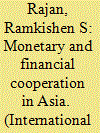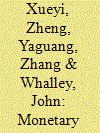|
|
|
Sort Order |
|
|
|
Items / Page
|
|
|
|
|
|
|
| Srl | Item |
| 1 |
ID:
092619


|
|
|
|
|
| Publication |
2009.
|
| Summary/Abstract |
Ever since the currency crisis of 1997-98, there has been a great deal of interest in enhancing regional economic cooperation in Asia. It is important to keep in mind that economic regionalism is of multidimensional nature. The focus of this paper is on policy initiatives underway in Asia to enhance monetary and financial regionalism and the analytical bases for these initiatives, rather than on examining the de facto level of financial and monetary links that already exists (which may or may not have been facilitated via regional policy mechanisms). There are many gradations of monetary and financial regionalism, ranging from the weak form involving regional policy dialog and surveillance, on the one hand, to exchange rate and monetary coordination, on the other. To maintain focus, this paper concentrates more narrowly on 'medium forms' of monetary and financial regionalism, broadly defined as the development of regional liquidity arrangements and regional financial markets.
|
|
|
|
|
|
|
|
|
|
|
|
|
|
|
|
| 2 |
ID:
087059


|
|
|
|
|
| Publication |
London, Macmillan Company, 1971.
|
| Description |
xiii, 304p.
|
|
|
|
|
|
|
|
|
|
|
|
Copies: C:1/I:0,R:0,Q:0
Circulation
| Accession# | Call# | Current Location | Status | Policy | Location |
| 007358 | 332.46/FOL 007358 | Main | On Shelf | General | |
|
|
|
|
| 3 |
ID:
123339


|
|
|
|
|
| Publication |
2013.
|
| Summary/Abstract |
In this paper, we discuss monetary thought in ancient China from the perspective of Western monetary theory. We set out the structure of economic activity in the various dynasties of ancient China and emphasize the differences in monetary structure from those of Europe and later North America. Imperial China was a politically integrated structure with regional segmentation of economic activities and hence with regional money. Monetary policy was conducted at the regional level but overseen politically. In various regions, different forms of money circulated, with gold, silver, copper, and paper money all presented at various times. Monetary policy was guided by monetary thought, as it was also guided later in Europe. Basic concepts, such as monetary functions, the velocity of circulation, inflation, interest rate parity and the quantity theory, were all present. The economics of Imperial China witnessed boom and bust, inflation and deflation and monetary control, similar to what was later seen in Europe. Chinese monetary thought thus seems to have preceded Western monetary thought and the two had remarkable similarities. Whether much of this thought traveled down the Silk Road remains unknown, but the possibility is intriguing.
|
|
|
|
|
|
|
|
|
|
|
|
|
|
|
|
| 4 |
ID:
052406


|
|
|
|
|
| Publication |
June 2004.
|
| Summary/Abstract |
Over the postwar period, states have shifted from cooperation in support of monetary guidelines, or standards for variation in wages, prices, and exchange rates, to the use of austerity as the primary means of maintaining monetary stability. In this article I offer a constructivist theory of international monetary relations in order to explain this shift, contrasting the effects of Keynesian and Neoclassical understandings on interests in cooperation. I argue that postwar Keynesian understandings, which cast monetary power as based in the authority to stabilize expectations, led states to perceive common interests in maintaining decentralized-but-legitimate guidelines. I then argue that more recent Neoclassical views, which cast monetary power as a function of capabilities, have justified reduced mutual assistance and greater recourse to austerity. From this vantage point, Neoclassical understandings, rather than any material constraints, impede the cooperation necessary to reconcile the impossible trinity of capital mobility, full employment, and monetary stability.
|
|
|
|
|
|
|
|
|
|
|
|
|
|
|
|
| 5 |
ID:
142892


|
|
|
|
|
| Summary/Abstract |
Within a year of the publication in 1987 of my historical account of the shifting priorities in Europe’s monetary and financial integration, dramatic first steps in a process of major changes in both areas were taken: In June 1988, the then 12 members states of the European Economic Community committed themselves to removing the residual controls on capital flows within a short time scale. And, in that same month, the European Council of Heads of State and Governments “confirmed the objective of progressive realization of economic and monetary union” and set up a committee, largely composed of national central bank governors, with Jacques Delors, then President of the European Commission as Chairman. The “Delors Report” of 1989 formed a stepping stone to the Maastricht Treaty, adopted at the end of 1991, and to the start of a common currency for 11 member states only seven years later. The scope and the speed of the process came as a major surprise, even to those most convinced of its net benefits, among whom this author has to be counted. Why did this strong momentum develop? And, in retrospect, would a more steady pace have been preferable?
|
|
|
|
|
|
|
|
|
|
|
|
|
|
|
|
|
|
|
|
|